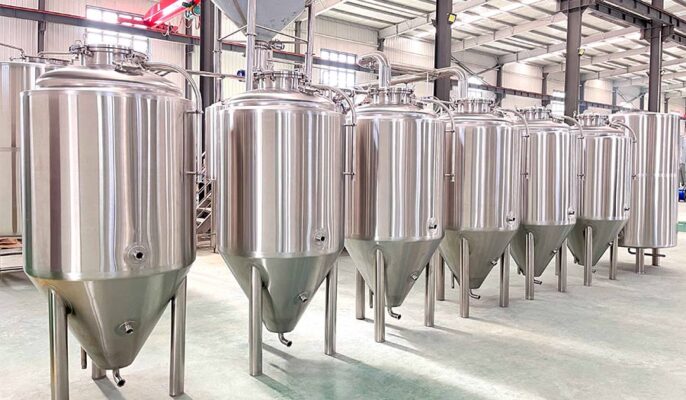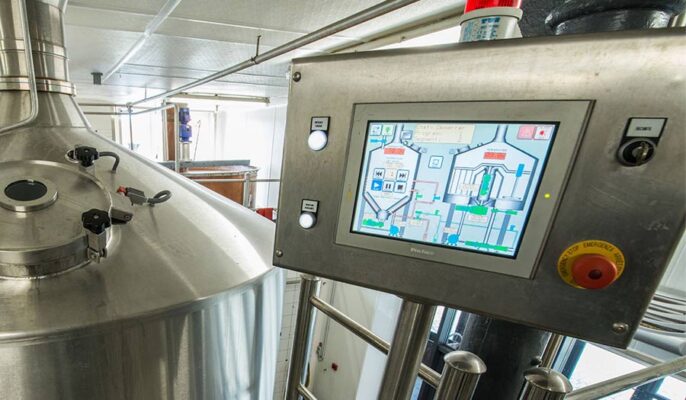温度管理は、最終製品の品質と一貫性を確保する上で重要な役割を果たす醸造工程の基本的な側面です。マッシングから発酵、コンディショニングに至るまで、醸造工程の各段階で温度をコントロールすることは、ビールやその他の醸造飲料のフレーバー、アロマ、全体的な特性に直接影響します。安定した温度は、醸造工程の一貫性を確保し、バッチ間のばらつきを減らし、すべてのビール瓶が期待通りの風味と品質を持つことを保証します。
なぜ発酵温度をコントロールするのか?
発酵温度のコントロールは、ビール醸造を最も進歩させる最大のステップでしょう。簡単に言うと、一般的なビール酵母は66~72°Fの範囲で最高のパフォーマンスを発揮します。この温度は、不要な異味をあまり出さずに酵母の働きを確実にするための最適な温度です。酵母は気温が高いほど増殖しますが、その過程でより早く増殖し、より多くのエステルを生成します。
異臭は、発酵温度が制御されていないことに関連していることがよくあります。
- フーゼルアルコール:ワインやウォッカのようなホットなアルコールフレーバーと思われがちだが、このフレーバーはコンディショニングの過程で消える傾向がある。
- エステル:フルーティー、バナナ、洋ナシ、あるいはマニキュアの除光液のようなフレーバーとして感じられることが多い。小麦ビールのような特定のスタイルではエステル類は歓迎されることもあるが、そうでないときにエステル類が襲ってくることも多い。エステル類はコンディショニングの間に落ち着くが、過剰摂取は時間が経っても改善されないことがある。
- アセトアルデヒド:青リンゴ、生のカボチャ、ズッキーニとして認識されることが多い。アセトアルデヒドはあらゆる発酵の自然な副産物だが、管理されていない状態では過剰に存在することがある。

麦汁の冷却はどのように行うのですか?
ほとんどの醸造所では、シングルステージまたはダブルステージのプレート式熱交換器を使って麦汁を冷却しています。この用途は要求が高く、プロセスから大量の熱負荷を除去する必要があります。水ループ内のグリコールと水の混合物は冷却効果を高めます。麦汁と冷却液の間の汚染問題を防ぐため、二重壁の食品用熱交換器がしばしば選択されます。
考慮すべき要素
- 冷却する麦汁の総量(通常、BBL/樽の容量で表される。)
- 必要なノックアウト時間(プロセスを最適化するために必要な冷却時間)。
- 麦汁の初期温度と最終麦汁の希望温度。
- チラーは他の醸造工程にも冷却能力を提供できますか?
醸造プロセスにおける温度管理の役割
マッシュ
マッシングでは、砕いた穀物を熱水と混ぜて発酵可能な糖を抽出し、麦汁と呼ばれる糖分を含んだ液体を作る。マッシング時の温度は、抽出される糖の種類と量に影響する。温度が低いと発酵可能な糖分が多く生成され、よりドライで希薄なビールになる。温度が高いと発酵可能な糖分が少なくなり、甘くコクのあるビールになります。正確な温度管理は、望ましい麦汁組成を達成し、残りの醸造工程の適切な基礎を確保するために、マッシングにおいて非常に重要です。
沸騰
マッシングの後、麦汁を煮沸して殺菌し、ホップを加えて苦味、風味、アロマを加える。煮沸の時間と強さは、ビールの最終的な苦味と個性に影響する。煮沸中の温度管理は、過度のカラメル化を防ぎ、安定した苦味のプロファイルを確保するのに役立つ。
発酵
発酵は、酵母が麦汁中の糖を消費し、アルコールと二酸化炭素を生成する重要な段階である。発酵温度は酵母の挙動に大きく影響し、様々なエステルやその他のフレーバー化合物が生成される。温度管理は非常に重要で、酵母株によって最適な温度範囲が決まっているからだ。温度が高すぎても低すぎても、風味が落ちたり、発酵が止まったり、酵母が過剰に活性化したりして、ビールの味や香りに悪影響を及ぼします。
コンディショニング
発酵後、風味をさらに熟成させるためにビールをコンディショニングする必要がある。コンディショニングの過程では、不要な化合物の分解や望ましいフレーバー化合物の生成など、望ましい化学反応を促進するために温度管理が不可欠です。適切な温度管理により、ビールは望ましい風味のプロファイルと透明感を得ることができます。

発酵醸造プロセスで温度管理が重要なのはなぜですか?
発酵中の温度管理
適切な温度でビールを発酵させることで、酵母が糖分をアルコールに変え、風味の強いおいしいビールができる。温度が高すぎたり低すぎたりすると、酵母の働きが鈍くなったり、完全に死んでしまったりして、うまく働かなくなります。
温度が低いとビールの酸味が増し、温度が高いとエステルやフーゼル油のようなオフフレーバーが発生することがある。従って、醸造プロセスを通じて麦汁の発酵温度に細心の注意を払うことが非常に重要である。
ビールの味と香りの形成
発酵温度はビールの風味とアロマに大きな影響を与える。温度が異なれば、出来上がるビールの風味成分も異なる。適切な温度であれば、酵母は素早く完全に糖分をアルコールと二酸化炭素に変換することができ、発酵効率と収量を高めることができる。温度が高すぎると、酵母は過熱により活性を失い、温度が低すぎると、発酵速度が遅くなり、不完全発酵になることさえある。ビール醸造において、温度管理は温度の風味と香りの形成に極めて重要である。ビールの活性に影響を与えるだけでなく、発酵過程で生成される様々なフレーバー化合物にも直接関係している。
醸造効率の向上
発酵温度を正確にコントロールすることで、醸造プロセスの安定性と予測可能性を確保し、生産効率を向上させ、生産コストを削減することができる。同時に、高品質のワインは高い市場価値と経済的利益をもたらす。
正確な温度制御を実現するには?
- 熱交換器:熱交換器は、沸騰後の麦汁を素早く冷却し、酵素反応を停止させ、オフフレーバーのリスクを低減するために使用される。対流式熱交換器やプレート式熱交換器は醸造所では一般的で、高温の麦汁から冷水に熱を伝え、両者を分離させる。
- 温度調節器温度調節器は発酵タンクを調節し、容器の温度をコントロールする装置である。温度を特定の範囲に保つことで、醸造家は酵母の最適な温度範囲に応じて発酵プロセスを調整することができる。温度調節器は精度と安定性を提供し、オフフレーバーや発酵停滞のリスクを軽減することができる。
温度管理のヒント
発酵温度を上げる
- 発酵槽を寝袋や断熱毛布のようなもので包む。発酵槽を包むことで、イーストの発酵によって発生する熱を閉じ込め、温度を上昇させる。
- 発酵槽を段ボール箱や断熱材の入った部屋に置くと、同様の効果が得られる。
- 温度をコントロールするもう一つの方法は、発酵槽を水の入ったバケツに沈め、水槽型のヒーターを使って温度を維持することだ。
発酵温度を下げる
- 最も簡単な方法は、発酵槽を湿らせたタオルで包むことだ。水分が蒸発すると、発酵槽の外側が冷える。
- これがうまくいかない場合は、発酵槽を約1~2インチの水の中に入れ、湿らせたタオルで包み、タオルが水に触れるようにする。こうすることで、蒸発に必要な水分が常に供給される。
- 水に氷を入れたり、扇風機を回して水をさらに冷やすこともできる。水の入ったバケツにカラフェを沈め、アイスパックを使って温度を下げることもできます。一定の温度を保つためには、定期的にアイスパックを取り替える必要があります。

よくあるご質問
なぜ発酵の過程で温度管理が必要なのですか?
発酵プロセスにおいて、温度は微生物の活性、代謝速度、発酵製品の品質に影響を与える重要な要素である。微生物はそれぞれ最適な増殖温度と発酵温度範囲を持っている。適切な温度においてのみ、微生物は急速に繁殖し、効率的に基質を目的の生成物に変換することができる。
発酵中の最適温度を決めるには?
発酵プロセス中の最適温度を決定するためには、微生物種、基質特性、発酵プロセス条件など、多くの要因を考慮する必要がある。
発酵温度を正確にコントロールするには?
発酵温度を正確に制御するためには、高度な温度制御機器と技術が必要である。一般的な温度制御装置には、恒温インキュベーターや発酵タンクなどがある。これらの装置には通常、精密な温度センサーと制御システムが装備されており、発酵液の温度をリアルタイムで監視・調整することができる。




